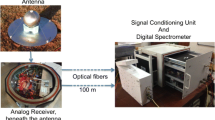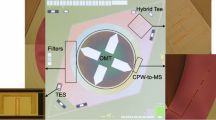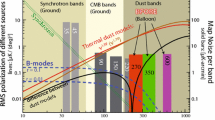Abstract
The Simons Observatory (SO) is an upcoming cosmic microwave background (CMB) experiment located on Cerro Toco, Chile, that will map the microwave sky in temperature and polarization in six frequency bands spanning 27 to 285 GHz. SO will consist of one 6-m large aperture telescope fielding \(\sim\) 30,000 detectors and an array of three 0.42-m small aperture telescopes (SATs) fielding an additional 30,000 detectors. This synergy will allow for the extremely sensitive characterization of the CMB over angular scales ranging from an arcmin to tens of degrees, enabling a wide range of scientific output. Here we focus on the SATs targeting degree angular scales with successive dichroic instruments observing at mid-frequency (MF: 93/145 GHz), ultra-high-frequency (UHF: 225/285 GHz), and low-frequency (LF: 27/39 GHz). The three SATs will be able to map \(\sim\) 10% of the sky to a noise level of \(\sim\)\(2\,\upmu {\hbox {K}}\)-arcmin when combining 93 and 145 GHz. The multiple frequency bands will allow the CMB to be separated from galactic foregrounds (primarily synchrotron and dust), with the primary science goal of characterizing the primordial tensor-to-scalar ratio, r, at a target level of \(\sigma (r) \approx 0.003\).



Similar content being viewed by others
Notes
The primordial B-mode has a second peak at \(\ell \lesssim 10\) corresponding to the epoch of reionization. These very large angular scales are not typically accessible from the ground, although this peak is a primary science target of possible upcoming CMB satellites, including the recently selected JAXA-led LiteBIRD satellite [10], and the ground-based CLASS [11] and GroundBIRD [12] experiments.
A more detailed discussion of the opportunistic scheduler can be found in Stevens et al. [21].
Manufactured by Criotec Impianti S.p.A., Chivasso, Italy.
Bluefors Cryogenics, Helsinki, Finland.
Cryomech Inc., Syracuse, NY.
We note here that the LPE’s are not band defining filters; band definition takes place via on-chip filtering integrated into the detector circuit.
Material A4K, shields manufactured by Amuneal Corp., Philadelphia, PA.
The magnetic shielding strategy will be discussed at greater length in an upcoming publication.
Designed and manufactured by Vertex Antennentechnik GmbH, Duisburg, Germany.
Consistent with the realized performance of the POLARBEAR and ACT experiments.
References
A.A. Penzias, R.W. Wilson, A measurement of excess antenna temperature at 4080 Mc/s. Astrophys. J. 142, 419 (1965)
D. Baumann, Cosmological inflation: theory and observations. Adv. Sci. Lett. 2, 105–120 (2009)
U. Seljak, M. Zaldarriaga, Signature of gravity waves in polarization of the microwave background. Phys. Rev. Lett. 78(11), 2054–2057 (1997)
M. Kamionkowski, A. Kosowsky, A. Stebbins, A probe of primordial gravity waves and vorticity. Phys. Rev. Lett. 78, 2058–2061 (1997)
M. Kamionkowski, E.D. Kovetz, The quest for B modes from inflationary gravitational waves. Annu. Rev. Astron. Astrophys. 54, 227–269 (2016)
G. Hinshaw et al., Five-year Wilkinson microwave anisotropy probe observations: data processing, sky maps, and basic results. Astrophys. J. Suppl. Ser. 180, 225–245 (2009)
N. Krachmalnicoff, C. Baccigalupi, J. Aumont, M. Bersanelli, A. Mennella, Characterization of foreground emission at degree angular scale for CMB B-modes observations. Thermal dust and synchrotron signal from Planck and WMAP data. Astron. Astrophys. 588, A65 (2015)
D. Hanson et al., Detection of B-mode polarization in the cosmic microwave background with data from the south pole telescope. Phys. Rev. Lett. 111, 141301 (2013)
The POLARBEAR Collaboration, P.A.R. Ade et al., A measurement of the cosmic microwave background B-mode polarization power spectrum at sub-degree scales with POLARBEAR. Astrophys. J. 794, 171 (2014)
M. Hazumi et al., LiteBIRD: a satellite for the studies of B-mode polarization and inflation from cosmic background radiation detection. J. Low Temp. Phys. 194, 443–452 (2019)
D.J. Watts et al., A projected estimate of the reionization optical depth using the CLASS experiment’s sample-variance limited E-mode measurement. Astrophys. J. 863, 121 (2018)
S. Oguri et al., GroundBIRD: observing cosmic microwave polarization at large angular scale with kinetic inductance detectors and high-speed rotating telescope. J. Low Temp. Phys. 184, 786–792 (2016)
A. Lewis, A. Challinor, N. Turok, Analysis of CMB polarization on an incomplete sky. Phys. Rev. D 65, 023505 (2001)
E.F. Bunn, M. Zaldarriaga, M. Tegmark, A. de Oliveira-Costa, E/B decomposition of finite pixelized CMB maps. Phys. Rev. D 67, 023501 (2003)
S.O. Collaboration et al., The Simons Observatory: science goals and forecasts. J. Cosmol. Astropart. Phys. 2019, 056–056 (2019)
A. Kusaka et al., Results from the Atacama B-mode search (ABS) experiment. J. Cosmol. Astropart. Phys. 2018, 005–005 (2018)
S. Takakura et al., Performance of a continuously rotating half-wave plate on the POLARBEAR telescope. J. Cosmol. Astropart. Phys. 2017, 008–008 (2017)
N. Galitzki et al., The Simons Observatory: instrument overview, in Millimeter, Submillimeter, and Far-Infrared Detectors and Instrumentation for Astronomy IX, ed. J. Zmuidzinas, J.-R. Gao, vol. 10708 (SPIE, 2018), p. 3
B.D. Sherwin, M. Schmittfull, Delensing the CMB with the cosmic infrared background. Phys. Rev. D 92, 043005 (2015)
P. Larsen, A. Challinor, B.D. Sherwin, D. Mak, Demonstration of cosmic microwave background delensing using the cosmic infrared background. Phys. Rev. Lett. 117(15), 151102 (2016)
J. R. Stevens et al., Designs for next generation CMB survey strategies from Chile, in Millimeter, Submillimeter, and Far-Infrared Detectors and Instrumentation for Astronomy IX, ed. J. Zmuidzinas, J.-R. Gao, vol. 10708 (SPIE, 2018), p. 136
C.A. Hill et al., A large-diameter cryogenic rotation stage for half-wave plate polarization modulation on the POLARBEAR-2 experiment. J. Low Temp. Phys. 193, 851–859 (2018)
K.P. Coughlin et al., Pushing the limits of broadband and high-frequency metamaterial silicon antireflection coatings. J. Low Temp. Phys. 193, 876–885 (2018)
J. Aumont, J.F. Macías-Pérez, A. Ritacco, N. Ponthieu, A. Mangilli, Absolute calibration of the polarisation angle for future CMB B-mode experiments from current and future measurements of the Crab nebula. Astron. Astrophys. 634, A100 (2018)
M. Silva-Feaver, M.S. Rao, μMux RF design for the Simons Observatory. J. Low Temp. Phys., this Special Issue (2019). https://doi.org/10.1007/s10909-020-02429-y
J. Iuliano et al., The cosmology large angular scale surveyor receiver design, in SPIE-International Society for Optical Engineering, vol. 78 (2018)
S.M. Simon et al., Feedhorn development and scalability for Simons Observatory and beyond, in Millimeter, Submillimeter, and Far-Infrared Detectors and Instrumentation for Astronomy IX, ed. J. Zmuidzinas, J.-R. Gao, vol. 147 (SPIE, 2018)
K.D. Irwin, K.W. Lehnert, Microwave SQUID multiplexer. Appl. Phys. Lett. 85, 2107–2109 (2004)
S.W. Henderson et al., Highly-multiplexed microwave SQUID readout using the SLAC microresonator radio frequency (SMuRF) electronics for future CMB and sub-millimeter surveys, in Millimeter, Submillimeter, and Far-Infrared Detectors and Instrumentation for Astronomy IX, ed. J. Zmuidzinas, J.-R. Gao, vol. 10708 (SPIE, 2018), p. 43
P.A.R. Ade et al., BICEP2. III: instrumental systematics. Astrophys. J. 814, 110 (2015)
Acknowledgements
This work was supported in part by a grant from the Simons Foundation (Award # 457687.)
Author information
Authors and Affiliations
Corresponding author
Additional information
Publisher's Note
Springer Nature remains neutral with regard to jurisdictional claims in published maps and institutional affiliations.
Rights and permissions
About this article
Cite this article
Ali, A.M., Adachi, S., Arnold, K. et al. Small Aperture Telescopes for the Simons Observatory. J Low Temp Phys 200, 461–471 (2020). https://doi.org/10.1007/s10909-020-02430-5
Received:
Accepted:
Published:
Issue Date:
DOI: https://doi.org/10.1007/s10909-020-02430-5




